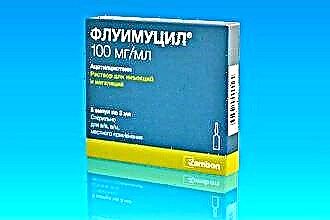Angina (tonsillitis) refers to infectious diseases, which in the majority of situations are accompanied by a significant increase in body temperature. Most often, a significant increase in temperature (hyperthermia) occurs due to the fact that a large amount of pus accumulates in the lacunae of the tonsils, which provokes the rapid development of pathogenic microorganisms and, as a result, the occurrence of hyperthermia. Depending on the type of disease, the temperature that accompanies each of the forms of angina will change.
Features of hyperthermia
The World Health Organization proposes the following classification of hyperthermia:
- subfebrile, which is in the range from 37 to 38 degrees;
- febrile, the values of which are in the range of 38-39 degrees;
- pyretic, high values up to 41 degrees;
- hyperperetic - critical values above 41 degrees, posing a threat to life.
Depending on the form of the disease, we can talk about how many days the fever will last and what maximum values it can reach.
It should be noted that the temperature with angina is most often moderate, the values of which do not exceed 39 degrees. As for the duration, with proper and timely treatment, the normalization of the condition occurs within three to four days after the onset of the disease.
- If the body meets with a catarrhal form, then the hyperthermia lasts no more than one or two days, after which the condition returns to normal.
- Follicular tonsillitis is more difficult, therefore, normalization does not occur until the third or fourth day of the disease.
- Lacunar tonsillitis is similar in symptomatology to the follicular form, so the temperature continues for at least four to five days.
- With herpetic tonsillitis, hyperthermia lasts an average of one to three days.
Important! The temperature with angina does not return to normal as long as pus is still present in the tonsils.
It should be noted that the approximate periods of temperature normalization for various types of disease are presented for a situation where timely and adequate drug treatment is carried out under the supervision of a specialist. If sore throat is not treated, then the time for the disappearance of symptoms and the process of normalization of the condition can continue for a longer period of time.
Symptoms of the disease
Experts distinguish between several main forms of the disease, depending on which the temperature with angina and symptoms can differ significantly.
- Follicular. This type of tonsillitis is always characterized by hyperthermia, which can rise to 38-39 degrees. Also, one of the main differences in this form of angina is the presence of abscesses on the tonsils.
- Lacunar angina is similar to follicular, but in this case, purulent plaque is localized both on the tonsils and in their lacunae. That is why the lacunar form is characterized by a higher temperature up to 40 degrees, as well as other symptoms characteristic of angina.
Important! If a patient with lacunar angina has a weakened immune system, the disease can proceed without fever.
- Phlegmonous. This type of disease is also called acute paratonsillitis. Phlegmonous tonsillitis occurs as a result of improper treatment of milder types of tonsillitis. In acute paratonsillitis, the tonsils become inflamed, as well as other tissues located in close proximity to the affected area. Hyperthermia in this case can reach pyretic and hyperperetic values. Symptoms such as increased weakness, chills, and enlargement of nearby lymph nodes are also observed. Normalization of the condition occurs only after opening the abscess.
- Also, forms of sore throats are isolated, flowing without an increase in temperature. In such situations, it is likely that the body can easily cope with the amount of bacteria that have entered it, or, on the contrary, is severely depleted.
- There is another type of acute tonsillitis, in which a low body temperature occurs.
Types of disease that occur without fever
The temperature with angina does not rise in the event of a catarrhal type of disease. Symptoms of tonsillitis include minor redness of the throat and mild enlargement of the tonsils. In adults, this uncomplicated form of angina causes moderate hyperthermia, which rarely exceeds 37.5 degrees or does not occur at all.
Important! Normal body temperature with angina does not mean that the infection does not require immediate and serious treatment.
There are also situations when angina proceeds not only without an increase in temperature, but also with a decrease. So a lowered body temperature happens as a consequence:
- severe depletion of the body;
- excessive hypothermia;
- loss of strength;
- improper nutrition;
- low hemoglobin levels, etc.
Also, the body temperature of adults can vary depending on the time of day, slightly different in the morning and evening. In this case, the lowered temperature can be normalized by eliminating the above reasons, as well as using hot drinks and warm clothing.
Low body temperature is as dangerous as hyperthermia.
Temperature normalization methods
If, in your case, angina proceeds against the background of hyperthermia, then you need to know how to lower your body temperature.
Important! With subfebrile values, that is, up to 38 degrees, it is not recommended to bring down the temperature.
If the body temperature rises above 38 degrees, then this indicates that the body cannot cope with the pathogen on its own, therefore, antipyretic drugs should be taken.
To eliminate hyperthermia, use
- medications;
- cooling the body with towel wipes. In this case, the fabric must be moistened in warm water, about 37 ° C, and the procedure should be carried out at room temperature not lower than 25 ° C.
Do not use hot baths, drink hot teas, use mustard plasters at elevated body temperatures. The main thing is to observe the drinking regime, that is, to consume the required amount of liquid, which will help the body in the fight against intoxication and prevent dehydration. For this purpose, you can use warm drinks, compotes, juices and fruit drinks.
If the temperature is high, it is important to stay hydrated.
Treatment of the disease
In order not only to eliminate the symptoms of angina and normalize the condition, but to cure the disease, getting rid of the negative influence of pathogenic microorganisms, complex treatment is necessary.
- Antibiotics are always used to treat sore throats. Indeed, otherwise, angina is dangerous for its complications, especially its purulent forms. Also remember that even after the symptoms of the disease have been eliminated, you cannot stop taking antibiotics on your own, since these drugs must be used in courses.
- Often, as a complication after taking antibiotics, the patient may develop dysbiosis. In order to avoid this complication, it is necessary to take special preparations rich in beneficial bacteria that can normalize the intestinal microflora.
- In the complex treatment of angina, antiallergic drugs are also used in order to prevent complications such as swelling of the tonsils.
- In order to locally help the body and reduce the amount of pus on the tonsils, rinsing is used with antiseptic solutions, as well as decoctions of medicinal herbs.
Important! If the temperature does not return to normal, then this symptom may indicate the development of complications or the occurrence of a chronic form.



